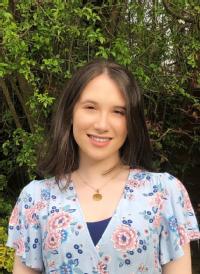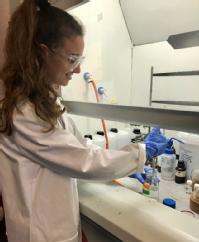Chemistry URSS Case Studies
 Mia Charlesworth
Mia Charlesworth
My name is Mia Charlesworth, a second-year Chemistry student, currently completing a URSS project with the Gibson Group. My project title is ‘Carbon dots as Sustainable Nanoscale Fluorescent probes.’ The project uses an exciting new type of fluorescent nanoparticle, which we make from simple sugars, as an alternative to metal-based nanoparticles which are already used in sensors, including COVID -19 lateral flow devices – which we all know about!
We are testing the quenching effect of different compounds, on carbon dots fluorescence to evaluate the use of carbon nanomaterials, as sensing probes. The enzymatic reaction I have researched is a glycosidase – an enzyme that breaks apart polysaccharides, which are important in biotechnology and potentially as targets for new drugs. This is normally tested for using a coloured substrate, but we are using the nanoparticles which may be more sensitive.
When adding carbon nanodots, the enzymatic product acts as a quencher and therefore as the concentration of the product increases, the fluorescence of carbon dots decreases. The goal of our study is to evaluate if using the carbon nanodots as probes, can detect smaller concentrations of the enzyme, than when no carbon nanodot probe is present. If this conclusion is valid this could help to improve and enhance biosensing.
The importance of probes is demonstrated through the countless applications that gold nanoparticles probes have, which are one of the most widely used nanomaterials in diagnostics. However, gold is disadvantageous as it is a non-sustainable resource, and it is not typically fluorescent.
URSS Opportunities
During this summer research project, I have learned how to use new software and instruments such as a microplate reader for absorbance and fluorescence spectroscopy. I have also improved skills taught in my undergraduate labs, such as micro pipetting and preparing solutions. New techniques have also been introduced throughout the project, such as how to create bioassays, which will undoubtedly be a technique that I will use in further research.
The URSS provides an independent research opportunity, which allows the student to experience a research environment first-hand. During my research project I usually completed three days in the laboratory, running the experiments and collecting data. Then for the two remaining days I analysed my data and read supporting literature.
The URSS is a phenomenal facilitator to improve laboratory skills and gives a student newfound confidence in the laboratory setting. I have also written a related blog article for Bubbling Up, regarding the apprehension that some students face when wanting to apply to a URSS.
I would like to thank the Gibson group and my supervisors Matthew Gibson and Marta Neves, who have made the experience fantastic and supported me throughout the URSS experience
 Lidón Pruñonosa Lara
Lidón Pruñonosa Lara
After my first year of university, summer 2018, I undertook an 8-week research project in the Dixon group - which involved structural characterisation of antimicrobial peptides in model membranes. During this experience of cutting-edge research, I not only improved my laboratory skills, but it also made me realise that research could be an interesting future carrier path. Now, three years later, I am about to start a PhD in Germany working with photoswitchable metallo-organic cages. Even though my research interests have changed since my URSS project, without this adventure I would not have met some truly inspiring scientists who shaped my academic journey.
Title of research project: Antimicrobial peptides by design
Publication: Molecular Basis of Selectivity and Activity for the Antimicrobial Peptide Lynronne-1 Informs Rational Design of Peptide with Improved Activity (https://doi.org/10.1002/cbic.202100151)
Brief outline of project: Antimicrobial peptides (AMPs) are found in all classes of life as part of the innate immune system. These peptides are potent, broad spectrum antibiotics with great potential as novel therapeutic agents and have been shown to kill Gram negative and positive bacteria, viruses, and cancer cells. AMPs are thought to specifically target several components of bacterial cells, including the cytoplasmic membrane. This project focused on the de novo design of AMPs that target bacterial cell membranes, using what is known about the sequence and structures of naturally occurring AMPs in the literature. Biophysical techniques (CD, Fluorescence, and NMR) were used to measure AMP-membrane interactions and refine the design.
What benefits could the project contribute to the community? The development of new antibiotics and antimicrobials is of urgent need, due to the fact that many infectious bacteria are developing resistance to larger numbers of existing antibiotics. This antibiotic resistance leads to longer hospital stays, higher medical costs and increase mortality. This project explored the fundamental physical interactions between a designed AMP and its biological target (a membrane bilayer), in order to direct the development of new antimicrobial compounds that may help combat resistant bacteria.

